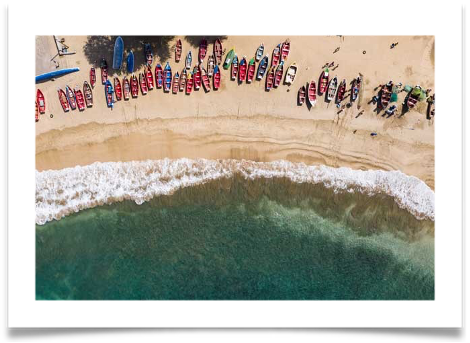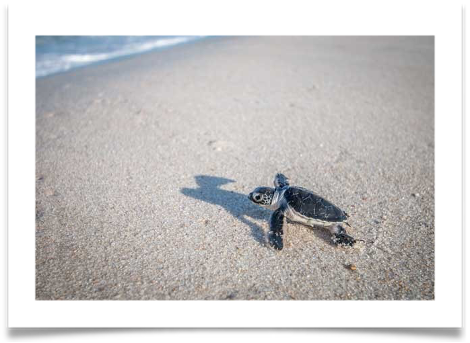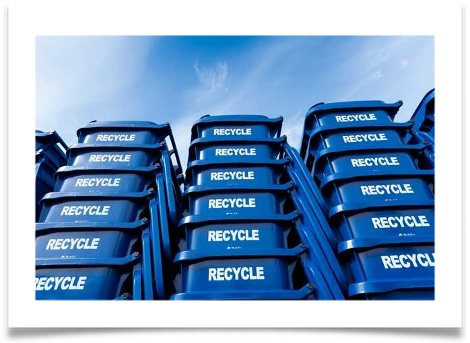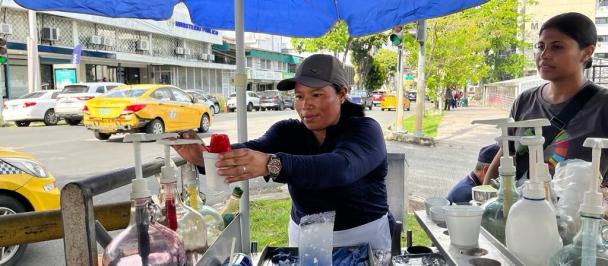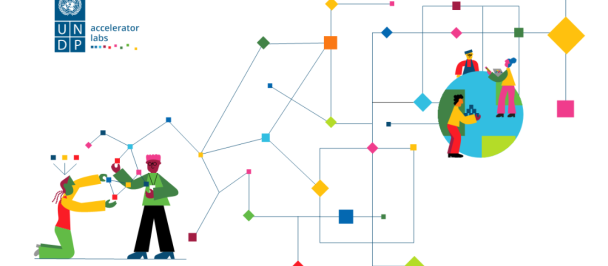Clean Beaches: Guarantee the Future of Sustainable Touristic & Coastal Zones
Clean Beaches: Guarantee the Future of Sustainable Touristic & Coastal Zones
September 1, 2020
Our Challenge
Cape Verde has a total area of 4.033 Km2, the archipelago consists of 10 islands (9 inhabited), it has an Exclusive Economic Zone (EEZ) with
734.265 Km2 and a coast of about 2.000 km from the continental shelf. This whole Zone has a rich marine ecosystem which allows a sustainable development growth of food supply that can respond to the growing needs of the planet and that contribute to the fight against poverty and value the untapped potential of the oceans and seas.
Tourism: Tourism cntributes directly to 20% to GDP, is the largest sector in the country's economy and the most promising development. Cape Verde receives close to 1 million Tourists annually looking for "Beach Tourism".
Biodiversity: Cape Verde is the 3rd largest turtle spawning site on our planet, is the 11th Global Hotspot for Terrestrial and Marine Biodiversity and is considered one of the 23 Marine Ecoregions of Global Importance for Biodiversity for the high rate of endemic species and home to emblematic species of world importance.
Our Challenge: Clean Beaches - Guarantee the Future of Sustainable Touristic & Coastal Zones Plastic has proven to be one of man's greatest enemies, the benefits it has brought for so many years, are now proving to be a problem for our planet. We all suffer and our country,
being immensely sea, our ecosystem suffers brutally from this evil, since all of it ends up in the ocean. Our Lab has as pillars of work the Blue Economy and the Tourism, and environmental awareness, protection and combating pollution are fundamental for the development of these two pillars.
Garbage cycle: Going through the entire cycle, from production, non-separation and placing in undue places or the lack of where to put them to the process of collecting aggregate waste and treatment, make us aware the scale of the problem! In certain coastal areas, where fishing or tourism, or even both, are the main population income, the probability or ease of licer going to sea is absolute. So, our initial focus is on working consciousness and tools.
Where: The place chosen for the realization of our experience was the beaches of the Capital of our country. Our capital has a population of 120,000 people in which the beaches are the main acraction on weekends and holidays, where the mainly influx are young people and with a strong culture of conviviality and parties on the beach where they cook, drink (alcohol also), leaving the beaches completely jammed with garbage produced. These parties are called karaka.
Our Project
What did we do: With the approach of the use of collective intelligence, we stripped ourselves of the pre concepts formed and focused in listen to the people we understand to be the experts in the area.
Who: First, we list our possible project partners, groups who contribute to our problem or who are affected by the problem addressed. We started a series of workshops, in which each one was rethought, and new stakeholders emerged with the learning we had. In all meetings, we made a presentation of what collective intelligence is.
COVID19: Cape Verde did not come out of this crisis unscathed and the pandemic caught us in the first week of our project. This led us, without being able to prepare ourselves, to stay at home, not being able to gather and taking into account the size of our country, very small and very close to each other, it was not easy to adapt to virtual meetings and productivity at a distance.
How we addressed the challenge: However, our goal was not to stick around. Our pre-this phase CI project was not the same project. Ager we have applied the technique, the ideas produced, and the engagement of stakeholders makes us believe that our project will succeed.
Some ideas produced and what we consider to be the actions that we will develop:
Best Tools
a) Collection tools on the beaches: This exercise should be carried out in total harmony with the Municipality. Now, the existing tools are neither sufficient nor effective. The municipality faces serious problems of lack of resources and even solutions that show that they can change the simple behavior of not throwing a plastic cup in the sand or having nowhere to leave all the garbage produced by a Karaka. We intend to identify the best and most effective tools, within a cost structure. This was not mentioned earlier in this note, but the municipality currently performs an incredible post-weekend cleaning job, done by workers who manually clean the beach and the area. But, of course, a large part of this garbage, before this work has already been carried out, will end up in the sea or melt (microplastic) mixing with the sand, impairing the quality of the beach and the fish food that is also our food. But of course, a large part of this garbage, before this work has already been carried out, will end up in the sea or melt (microplastic) mixing with the sand, impairing the quality of the beach and the fish food that is also our food.
b) Mobile application - Nha Praia: Together with the partners in the IC sections, he suggested the idea of developing a mobile application that will have a front office and back office. Being the front office aimed at the citizen, where when using the application you will have information about the beach where you are, safety conditions for using the beach, idenOficaOon of places for dumping garbage, awareness content and in addition, the citizen can contribute with information for the municipality, communicating anomalous situations that the municipality must resolve. The municipality on your side, in the back office, will be able to view the problems sent. The municipality can also give feedback to the citizen, creating trust and greater harmony in this work that belongs to everyone. We also created the concept of beach ambassadors, who are activists or owners of commercial spaces on the beach, who will be the supporters, guards, and representatives of the beaches with citizens in their daily lives and in the continuous work of - clean beaches. Ambassadors will also have access to the back office to be the municipality's work watchmen, but they will also be able to support the municipality in solving problems when possible.
c) Area identification: Considering the logic of experimentation and already with the objective of successfully replicating it, the idenOficaOon of the area to apply the project is fundamental. The beaches and coastal areas have particularized and it is necessary to make a real survey of each situation. Here are some of the points we've identified as crucial for surveying: Beach area; Ability of bathers - will allow us to get an idea of the production of garbage; Number of the existing collection means on the beach; Number of existing collection facilities in the vicinity of the area; ForecasOng the number of the collection means required; Collection of temporal satellite images for analysis of change of views indicating pollution levels.
d) Signs on the beaches: We believe that being on signage will support awareness. The signage will report the existence of the app.
Behavior change
We intend to carry out sensibilization campaigns on social networks, in the mass and accessible media such as community radios. We also expect to have the engagement/hiring of social effluents so that the word reaches young people.
New insights and learnings on waste management
What were your top insights/discoveries?
Do not choose the problem of others: During the training, we learned a lot from the intricacies of CI. We begin by realizing that we are not the flavors of the subject, that we need others, and that we must undress from preconceptions and open to learn new ones and undo some. One of the main lessons learned was the concept of Bias and in this, we highlight our decision to decide what the municipality has on its agenda. The municipality has the role of cleaning the city, waste collection, and treatment. But the way he does it and his agenda, it's not the same way we designed for this project or that we created to the extent that we developed the CI with the stakeholders. The municipality does not focus on behavior change, not because it does not interest them, but its work is in the realization of cleaning and awareness they leg on the agenda of other enOOes. UnOl then we have not felt the institutions ment and we run the risk or the need to change what we call project partners.
Lightbulb moments on use of CI
What are your insights and reflections on using CI in this project?
As already addressed the CI made us fall off the pedestal and listen, perceive visions, opinions, know data and think together and differently. The project today is not even close to what it was initially. And mainly it allowed us to surprise with solutions that alone we would not get there. This practice will have to be maintained because things will still have to change a lot. The CI lowers the risk of taking things, such as bias, and thus have less risk of failure. However, the CI also takes its time and often not only wins but is lost. The need to listen, collect information takes time to buy time, but everything has to be in the right measure.
What worked?
No doubt the key so far in this project are volunteers. We have learned a lot from the associations and activists who have brought information that has never come to us except for them who face the problem over another sphere – that is love for the cause, stripped of political influences.
Outlook: what next?
Change of focus:
Given the situation already addressed here, we face the challenge of having the same focus – to ensure the sustainability of coastal areas and tourism, but we cannot depend on an institution, wanting their agenda to be ours. We are thinking of re-adapting the coastal zones project, with the support of community associations and focusing on young people and behavior change. However, given the municipality's responsibility to keep the city clean, the municipality will continue to be one of our challenges. But we're going to have to take approaches using CI and especially people to generate ideas that work.
How might CI inform future work tackled by your team/country office?
The exercise of CI is a change of attitude towards the day to day, so it is essentially a stripping of the role of a connoisseur to a listener. This opens our chances completely and diminishes our risks. Therefore, CI is already and will continue to be our way of addressing challenges, designing, and exercising our experiments.

 Locations
Locations